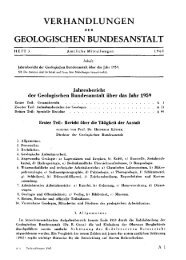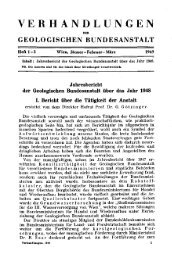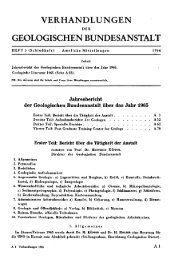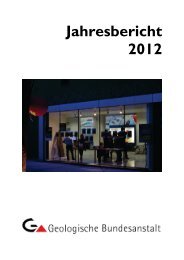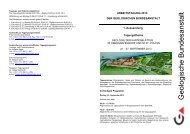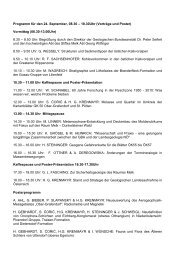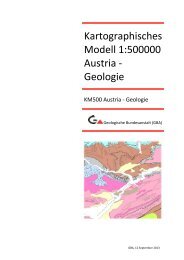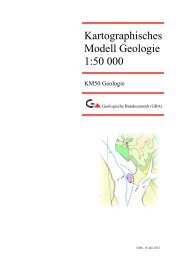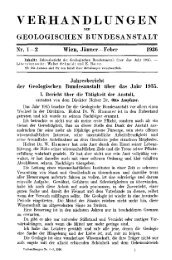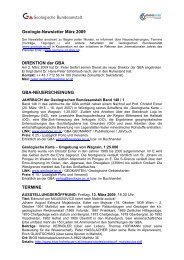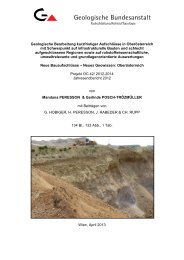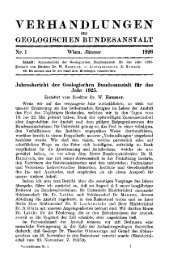Field Trip B TRIASSIC CONODONT LOCALITIES OF THE ...
Field Trip B TRIASSIC CONODONT LOCALITIES OF THE ...
Field Trip B TRIASSIC CONODONT LOCALITIES OF THE ...
You also want an ePaper? Increase the reach of your titles
YUMPU automatically turns print PDFs into web optimized ePapers that Google loves.
e observed. The dip angle depends on the age of the beds (see fig. 12 a) in such; a way that the base of<br />
the stratigraphic oldest bed VII is almost vertical and its upper bedding plane has an inclination of some<br />
50 . The angle decreased to about 20° in the Lower Norian (bed II). Finally, bed I overlies this<br />
structure with a dip angle of approx. 15°. Subsequent tectonic movements were responsible for the<br />
opening of fissures which in quarry F 4 were infilled by Upper Norian „Rotkalk" (bed B 3) and in<br />
quarry F 5 by Middle Norian „Rotkalk" (bed F 5/B).<br />
Within Upper Karnian time the Feuerkogel represented an area of non-deposition presumably caused<br />
by a local submarine ridge and by currents. During that time the depression of the graben in the<br />
quarries F 4 and F 5 acted as an ideal fossil and sediment trap. The infilling of cephalopod shells was<br />
accompanied by continuous sedimentation and thus condensation did not occur. Detailed study led<br />
to the recognition of 7 distinct beds which are described in the following paragraphs. Lithologically,<br />
beds VII to II consist of „Roter Bankkalk", the uppermost bed (I) consists of „Massiger Hellkalk" and<br />
gradually passes into non-fossiliferous beds (1 + 2).<br />
Quarry F 4 was designated as stratotype of the Tuvalian Stage by KRYSTYN & SCHLAGER 1969.<br />
This procedure has been supported by recently achieved results of ongoing studies. For example, in the<br />
basal part of bed VII (quarry F 5) a distinct and large ammonoid fauna of the lowermost Tuvalian Dilleri<br />
Zone has been found; or a continuous faunal record has been recognized which enabled a precise<br />
determination of the Karnian/Norian boundary between beds IV and III.<br />
Fig. 12 b demonstrates the generalized bed sequence of quarries F 4 and F 5. Correlation is based<br />
on a distinct lithology (e. g., marker beds IV and III) as well as on faunal evidence. The basal bed VII<br />
is not included in the figure because it is fully represented only in quarry F 5 (fig. 12 a); also, for the<br />
study of faunistic changes at the assumed Karnian/Norian boundary it is not so important. In fig. 12 b<br />
stratigraphically more important ammonoids, halobiids and conodonts are summarized (we refer to<br />
this chart; for additional reference see KRYSTYN 1974 a). All beds contain a fairly rich conodont fauna<br />
dominated by platform conodonts in a frequency between 50 and 200 specimens per sample (1 kg).<br />
Bed VII: This bed was subdivided by partings into 4 levels, the lower two containing a distinct<br />
ammonoid fauna assigned to the DilleriZone (Tuvalian 1): Tropites cf. dilleri SMITH, Gymnotropites<br />
dinaricus (DIENER), G. sulcatus (CALCARA teste GEMMELARO), Discotropites sp., Sirenites betulinus<br />
(DITTMAR), Spirogmoceras cf. lecontei (SMITH), cf. Neoprotrachyceras n. sp., Trachysagenites<br />
glamocensis DIENER, Traskites sp. and Halobia superba MOJS. (VII/3). The only platform conodont<br />
found is G. polygnathiformis.<br />
The upper two horizons in both quarries contain a typical Tuvalian 2 ammonite fauna as described<br />
in earlier reports (KRYSTYN & SCHLAGER 1971, KRYSTYN 1973). Additionally can be stated that<br />
Tropites subbullatus (HAUER) has been found to be restricted to the uppermost level of the bed thus<br />
representing the Tuvalian 2/II-subzone. The conodont fauna of level VII/1 is marked by the appearance<br />
of rare Gondolella nodosa.<br />
Bed VI and V/2 (F4): They are the main layers of the ammonoid genera Hoplotropites<br />
and Jovites; a further distinct species is Eusagenites tschermaki (MOJS.) referred to Malayites sp. by<br />
KRYSTYN 1973, p. 120. The platform conodont fauna comprises G. polygnathiformis and G. nodosa<br />
in a relative abundance ratio of 3—5: 1. Age: Tuvalian 3/1.<br />
Bed V resp. V/I (F4): The ammonite fauna is dominated by juvavitids (Projuvavites, Gonionotites)<br />
and scarce tropitids (Anatropites, Hoplotropites). G. polygnathiformis and G. nodosa are<br />
found in an almost equal ratio, together with first representatives of Epigondolella primitia. Age: Lower<br />
Tuvalian 3/II.<br />
Bed IV: The ammonite fauna is dominated by juvavitids and the stratigraphically more important<br />
genera Anatropites, Microtropites and Thisbites. Concerning platform conodonts a remarkable<br />
faunal break occurs between bed V and IV: G. polygnathiformis and G. nodosa disappeared and are<br />
replaced by abundant representatives of Metapolygnathus communisti morphotype A associated with<br />
E. primitia and rare E. abneptis. Age: Upper Tuvalian 3/II.<br />
Bed III: The ammonite fauna is marked by the appearance of distinct Norian genera such as<br />
Dimorphites and Griesbachites; other common genera are Gonionotites, Thisbites and Styrites. The<br />
platform conodont fauna is composed of abundant M. communisti morphotype B together with E.<br />
primitia, E. abneptis and Gondolella navicula. Age: Lacian 1/1.<br />
Bed I I : It is divided by a thin bedding plane which represents the boundary between the Jandianus<br />
and the Paulckei Zones.<br />
Bed I I / 2 : It yields an ammonite fauna dominated by the genus Guembelites; otherwise it re-<br />
86



